Shares of Micron (MU +7.76%), one of the major players in both the DRAM and NAND markets, look extremely inexpensive. The stock fell considerably after the company reported its third quarter earnings last month, and it currently trades at just 7.5 times last year's earnings and seven times the average analyst estimate for fiscal 2015.
But that valuation is deceptive. The DRAM that goes into memory for PCs, servers, and mobile devices, and the NAND that goes into solid-state drives, are standardized and largely commodities. DRAM from Micron is equivalent and interchangeable with DRAM from any of its competitors, and like any commodity market, exceptional profits come only when demand outpaces supply.
Supply and demand
In 2014, Micron made a killing, but this followed a few years of oversupply in the industry. During the past decade, Micron posted a negative operating margin 40% of the time, and it even posted a negative gross margin during the worst years of the financial crisis. From 2005 through 2013, Micron recorded a cumulative operating loss of about $1 billion.
While industry consolidation has led to fewer competitors, and while the growth of smartphones has led to strong demand, the DRAM and NAND markets are still susceptible to oversupply. In the most recent quarter, the company reported that DRAM average selling prices slumped by 10% year-over-year, while its cost per bit of DRAM only fell by 6%.
The price of DRAM per bit generally falls over time. Putting 8GB of RAM into a PC today has become standard and inexpensive. Ten years ago, that amount of RAM was unaffordable.
The game that DRAM manufacturers play is simple: The costs per bit of DRAM produced needs to fall at least as fast as the average selling price per bit. Otherwise, margins begin to contract.
During times of oversupply, average selling prices can fall so quickly that it becomes impossible to turn a profit. In 2011, DRAM average selling prices for Micron fell by 39%, followed by an even larger 45% decline in 2012. NAND selling prices fell even faster in 2012, dropping by 55%. It is no wonder, then, that Micron reported a net loss of more than $1 billion that year.
Since then, things have gotten better. There are now only three major DRAM manufacturers, following Micron's acquisition of Elpida last year. Demand for the DRAM that goes into smartphones is booming as both sales of smartphones and the amount of RAM per smartphone surge. In 2014, Micron reported a net income of $3 billion on $16.4 billion of revenue.
But fewer competitors and strong demand does not make the industry immune from oversupply. Even with just three major players, all it takes to plunge the industry into losses are some overly optimistic assumptions about demand. Short of collusion, there is no way to ensure that 2012 will not repeat itself.
This is the problem with investing in a company like Micron. The stock looks tantalizingly inexpensive, but all of those profits could disappear in an instant, just like they did following the very profitable year of 2010. During the past five years, which excludes the worst years of the recession, Micron managed an average operating margin of 9.9%, a bit more than half of its operating margin during 2014.
After interest and taxes, using the tax rate and revenue from 2014, net income would come out to about $1.2 billion. The price-to-earnings ratio based on this number is a far less enticing at 18.5 times. At the stock's peak at the end of 2014, the price-to-earnings ratio was a sky-high 35 times.
Be careful with Micron
Micron is a stock that can burn you if you are not careful. There is little reason to believe that the exceptional profits that the company managed in the recent past are sustainable, and on average, I suspect that profits will be far lower going forward.
The risk that oversupply drives Micron into the red is ever present, and ignoring that risk is a bad idea. Because of this, Micron stock is not nearly as cheap as it appears.






